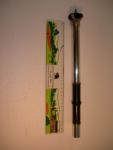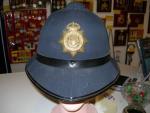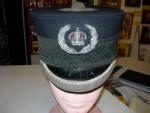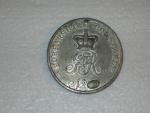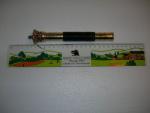-
Posts
13,225 -
Joined
-
Last visited
-
Days Won
22
Content Type
Profiles
Forums
Blogs
Gallery
Events
Store
Everything posted by Mervyn Mitton
-
Hi. 1900 was the year of manufacture - I would say the likelihood of it being used in South Africa is high - but we would have to eastablish which unit it was issued to. Value wise - a complete one , in good condition, is about ?200/300. I am afraid without a scabbard you will be lucky to get ?100. Best wishes - our temp. at present is 28c - in the shade - on most days , so, a little of your weather would be welcome. Mervyn
-
I was in 'H' Div. stationed at Bethnal Green - I nearly resigned when I was first posted - I had delusions of grandeur and wanted 'B' and Knightbridge - in fact I greatly enjoyed the East End and found the real East Enders genuinely nice people. Where are you stationed ? My favourite Comm. was Sir Robert Marks - he was put in to shake up the Met. and he certainly did that. Change is inevitable, but we 'oldies' don't have to agree - read Brian's comment above. Best wishes Mervyn
-
I should have added that this is not the correct scabbard - it should be all metal and with two suspension rings. Mervyn Mitton
-
One other point to Robin's reply, is that many of our colonial police forces were para-military and with the climate were often in khaki. South African police ranks for officers were based on their military counter parts - however, after 1994 (Govt.change) they had senior officers from the Met. advise them and they now follow the British style. Mervyn
-
Dear Brian - a nice helmet and with good enamelling. I quite understand why you keep it behind glass - everyone, and their dog, wants to put on a British helmet. When I was in the Met. I was a home-beat officer - nowdays, I think they call them Community Officers. I had an area with some 20000 people and it included 4 schools - if I gave talks, the kids always wanted to play with the helmet, so, how did I get around this - bearing in mind that even in the '70's head lice were a problem - I used to take any spare one from the locker room... Should you be interested to add to your Staffordshire collection , I have a rare 'Noddy' helmet I would be willing to sell for a fair price. This helmet has re-inforcing and a leather chin strap that is in two parts. For a short period Velocette motor cycles were introduced for Beat patrols. The officers didn't have to have full training and it was thought they would make getting around easier. They were not a success and didn't last long, which makes this rare - I also have one for the Met. - and yes, the name does come from Enid Blyton. Look forward to seeing your other pieces. Mervyn
-
Paul These are very good examples - and always remember - the RUC guarded their equipment more vigilantly then the mainland forces - so these are very collectable. I used to have two rare badges for the Belfast Harbour Police,not sure where they are now. Thankyou for sharing - now, with your influence - get everyone else to post - I think in two days we've exceeded last year !! Mervyn
-
This is the head of the Magistrate's tipstaff for Shadwell. A lovely George 111 crown - hallmarked for 1802 and all silver - made by a famous silversmith of his day. Should anyone be interested I could go into more details with the early public offices. Out of interest -the first time the word POLICE was used officially, was in the Dublin Police Act - of, I think, 1792. Mervyn
-
I broke my promise - sorry !! However, it's taken me three days - and a computer expert - to find out how to download pictures - so, my motto - strike while I can remember.. This is not the rarest piece in the collection - many of those have now gone - however, it is an important part of our British police heritage. The first Public Office was set-up at Bow Street in 1748 and ran under the Fielding Brothers (of Tom Jones fame) for many years - it included the Bow Street Mounted Patrol, the Bow Street Runners and of course, the magistrate, three constables and their helpers. They also had cells and a matron for the women prisoners. Bow Street was so succesful that in 1792 a further 7 Public Offices were established in different parts of London. One of them was at Shadwell - which is immediately to the East of the Tower of London and included a very rough part of the East End. This tipstaff has the hallmark for 1802 and is engraved 'CONSTABLE OF SHADWELL' . One has to understand that a magistrate had different functions in those days and was also directly in charge of his police officers (if you have seen 'Treasure Island' you will remember the magistrate arrives to take charge with his constables) - so, although he is referred to as Constable, it is the magistrate they mean. Anything to do with the early Offices is rare and valuable - about ?4000 ! Will try to show the top in next post. Mervyn
-
Will Very similar - although the civic guard also had military jobs - i.e. guarding power stations , docks etc.. We also have a reserve for the S.A.P. -which is still active, but I must look-up when it was formed. My problem is that I carry this info. in my head and at my age that's not always wise !!! Mervyn
-
Dear Will Nice to see a complete uniform - outside of museums they just don't seem to exist. I am pretty sure that this helmet is the 1st. pattern - slightly taller than the 2nd. - if it says 'POLITIE' and not 'POLISIE' it is the pre-1926, or 1st. Now... if everyone else will also post something, I won't feel like I'm staging a coup !!! Mervyn
-
http://gmic.co.uk/uploads/monthly_03_2009/post-6209-1237724871.jpghttp://gmic.co.uk/uploads/monthly_03_2009/post-6209-1237724871.jpg Last one - promise !! During the 1st.WW so many Police joined the Services that they were left only with small numbers. The War Reserve Police were formed - in nearly every town - the big problem was that they had no uniforms. Each man was issued with a truncheon, an identifying lapel badge and an arm band - saying he was a constable. These varied from force to force and are now very collectable - and unlike some items are not too expensive. Sometimes they made the badge to hang from a button. After the war each constable - at least in the midlands - receive a commemorative truncheon with a transfer of the town arms - these are highly collected. Mervyn p.s. can anyone delete the SA helmet where the wording didn't come out ?
-
The SA Police were formed in 1913 - from a mix of small forces, many of which had sprung-up after the Boer War. There were two patterns of helmets - the first similar to a British helmet in shape and with a similar helmet plate. This is the 2nd. pattern - dating fom the 1930's to just after the 2nd. WW. Because of the SA habit of giving items like this to the gardener, not many have survived - however, the plates are available. Mervyn
-
Reading through past Police Posts , I was surprised to see that for the whole of last year there were only 12 ! We really are the 'forgotten' service - until you need one, that is - and then there is never one around !! I have no wish to look as if I'm trying to take over this forum - however, if I post a number of different items it might spur others on to show pieces from their collections. I will 'do' another 2 or 3 and see what reaction ? This lovely cap is the pattern for Inspectors and Superintendents - although this one is a Supt's. - they date from the 1890's to about the 1st WW. Prior to this the army and officers of police were wearing the horrible little pillbox - this sat on the side of the head and to hold it on the strap always had to be down. Basically, they made it a little larger and added a peak - also, for ranks of Supt. and above , they added bullion on the peak. This particular cap has a King's crown - so, is for Edward V11 (1902-1910). Being collectors we always ask - How much ? About ?150/200 - it is rare, so perhaps a little more. Mervyn
-
Dear Robin Thankyou for replying - I knew your name immediately, but associated it with PICA (Police Insignia Collectors Assoc.). I actually use some of your books to help with identification in the shop - so, I am most impressed. I cannot pretend to have a great knowledge of German collecting - we always keep some good pieces in the shop - but,I find the collectors know more than I do on this subject. With the Police Acts of 1839 and 1856 many Forces have had their 150th. in recent years and I was pleased to see that they have taken their history more seriously and most have prepared and issued Force Histories to commemmorate the event. I have seen many of them and they add greatly to our knowledge - unfortunately, although policing affects all of our lives , it is the forgotten service. I think this is partly because our equipment is not glamorous and really hasn't changed much since 1829. I thought you might like to see this constable's badge of office for Forfarshire ( where is it exactly?). Dates back to George 1V (1820-1830) and is cast in pewter - since it covered a County there was more than one required - so, they put a blob of solder on and impressed the constable's number. The badge would have been around his neck on a ribbon - cheaper than a tipstaff, but , it makes it rare. Mervyn
-
British officers on combat duty did not - as a rule - have their dress words with them during WW2 - so fairly unlikely for hand to hand. The only sword surrendered in the War by a Western commander (to the best of my knowledge) came into our shop for repair. The South African campaign in Ethiopia was one of the finest during the war and has never had the recognition it deserves. We had approx. 28000 men who started in Capetown and drove through Africa picking-up men as they went. They quickly had the upper hand - despite the Italians having some 250000 men - and a captain in the King's African Rifles (Kenya) had the surprise of his life when he was summoned to the Commander in Chief of the Italian forces - The Duke of Aosta - who surrendered his sword to him. He was allowed to keep it - and the family left it in a garage to rot ! Despite being for such an important person it wasn't of very high quality - our silversmith repaired it and it is now back with the family in Natal. Mervyn Mitton
-
An interesting sword - I wonder what it was doing in Iceland - of all places? It is the 1890's pattern British cavalry troopers sword and according to the engraving on the forte (the part of the blade just under the guard) was first issued in 1900.('00) This , of course, makes it a Boer War period sword. (Boer War 1899-1902). This pattern first appeared in 1864 - and despite modifications remained in service until 1908. During the Boer War there were several instances of men falling out of their saddles during the charge - the problem being that the sword had become too heavy and shifted the centre of balance. After the war finished the British set-up a Royal Commission to investigate the problem - a serious one since in one instance an entire troop of some twenty men were unhorsed. The answer to the problem was the 1908 cavalry sword which was pointed and carried into battle with arm extended - unlike the shown example which was for slashing. The 1908 (and the officers version in 1912) has always been regarded as one of the best balanced sword ever made. Your blade has British Board of Ordnance marks for being sold out of service, so, I suppose someone bought it and it has ended up in Iceland -- could be useful for polar bears - do you have them in Iceland? Mervyn Mitton
-
Dear Brian These old helmets just don't seem to be around any more - even the silver badge is worth a great deal. Since I am slowly disposing of my collection this helmet was in our shop - the medals that have shown-up are part of the back wall which is covered with them -so, they are not really part of my personal collection. I will put an exceptional Supt.'s 1900 cap on tomorrow. Mervyn
-
Thankyou for your comments. You are quite correct in ranks and the use of tipstaves - also, Chief,Deputy and Asst. chief constables in the County forces also wear them. The only official 'tipstaff' to exist is stationed at the High Courts at the Strand in London - he actually still carries an early Victorian one. I also found out that in Australia, they have a number of officials known as Tipstaffs. The particular pattern I have shown here is about 7 inches long - it stands alone and was not mounted on anything - the officer would have held it in his right hand - arm extended, and announced his position and requirements. When transportation was still a way of populating the colonies, to resist arrest - when you had been touched by the staff - carried a further 7 years transportation. I have always had a strange feeling when holding these old pieces - they are the history of law in the UK and without them the constable (or, other user) could not perform his duty. Swords and firearms were produced in their thousands - rarely are there more than one pattern of a tipstaff - or, decorated truncheon. I can show many more old items - just don't want to be a bore ! The other interesting thing is that the British don't easily give-up their traditions and I have found tipstaffs in Canada;S.Africa;Australia;India and Sri Lanka. The USA had Admiralty Courts and Maces - so there are - somewhere - the smaller tipstaffs carried by the officers' of the Court. NZ did not use them - at least I have never seen one. Mervyn
-
This interesting British Police Helmet probably belonged to the head Constable of Birmingham ( a large UK city) in the 1870's. Prior to that the police wore tophats, but in the 1860's Germany was the pre-dominant army and we copied their uniforms for our military - with the police in turn using the same pattern. Our present helmets are a direct descendent of the German helmet. The spike on the helmet is unusual - the army used it for Infantry officers - but in those days a head constable was often made from retired army officers and this style was obviously a one-off choice. What is rare is that all the fittings (or, furniture) are made from silver. Most people will know that the chain around the helmet is the ceremonial way of wearing the chin strap. I will put an original top hat on if it is of interest? Mervyn Mitton
-
Badges of authority have been around as long ago as the ancient Sumerians (5000 years BC) - the English have certainly been using them for the past thousand years. By the 19th.C. the appearance of the tipstaff had become more uniform - but, still varied according to the wants of it's owner. The police came to use a standard design from the 1840's onwards and Inspectors and Superintendents wore a small leather case on their belts - this had a concealed spring in the base and when opened the tipstaff 'popped-up' ready to be taken out and show the bearer's authority. This one was for an Inspector in the City of Leeds Police and has his name,rank and the name of the Force. Very rarely do the cases remain with the tipstaff and certainly not often in this condition. They ceased to be used when Warrants and I.D.'s were introduced in the 1880's. I will be happy to put-on more examples if they are of interest - also, some early uniforms. Mervyn Mitton
-
http://gmic.co.uk/uploads/monthly_03_2009/post-6209-1237473267.jpgI am enclosing an attachment of a tipstaff for the middle Victorian period - 1850 - 1860's. This was carried on the belt in a leather case - next picture - by Inspectors and Superintendents. Hiatt's , the famous handcuff makers , produced this pattern. This particular tipstaff was for an Inspector of the Leeds Police. I will post other images if members are interested. Mervyn Mitton
-

Past Posts
Mervyn Mitton replied to Mervyn Mitton's topic in Great Britain: Mervyn Mitton's British & Colonial Police Forces
Thankyou Will - will look forward to seeing you. Saw your 2nd posting for your collection - as everyone is saying - quite incredible ! You certainly won't need a pension plan. Best wishes Mervyn -

Past Posts
Mervyn Mitton replied to Mervyn Mitton's topic in Great Britain: Mervyn Mitton's British & Colonial Police Forces
I appreciate your encouragement - with the internet you can never judge what people are thinking , and I appreciate that Police are not top of the collecting 'heap'. I have a number of good photos of rare tipstaffs, recently taken for a customer in the States - once I master my 'Photo Impressions' programme I will down load them to GMIC. Meanwhile,if you really think people would be interested I will do a few condensed articles. Thankyou Mervyn Mitton




